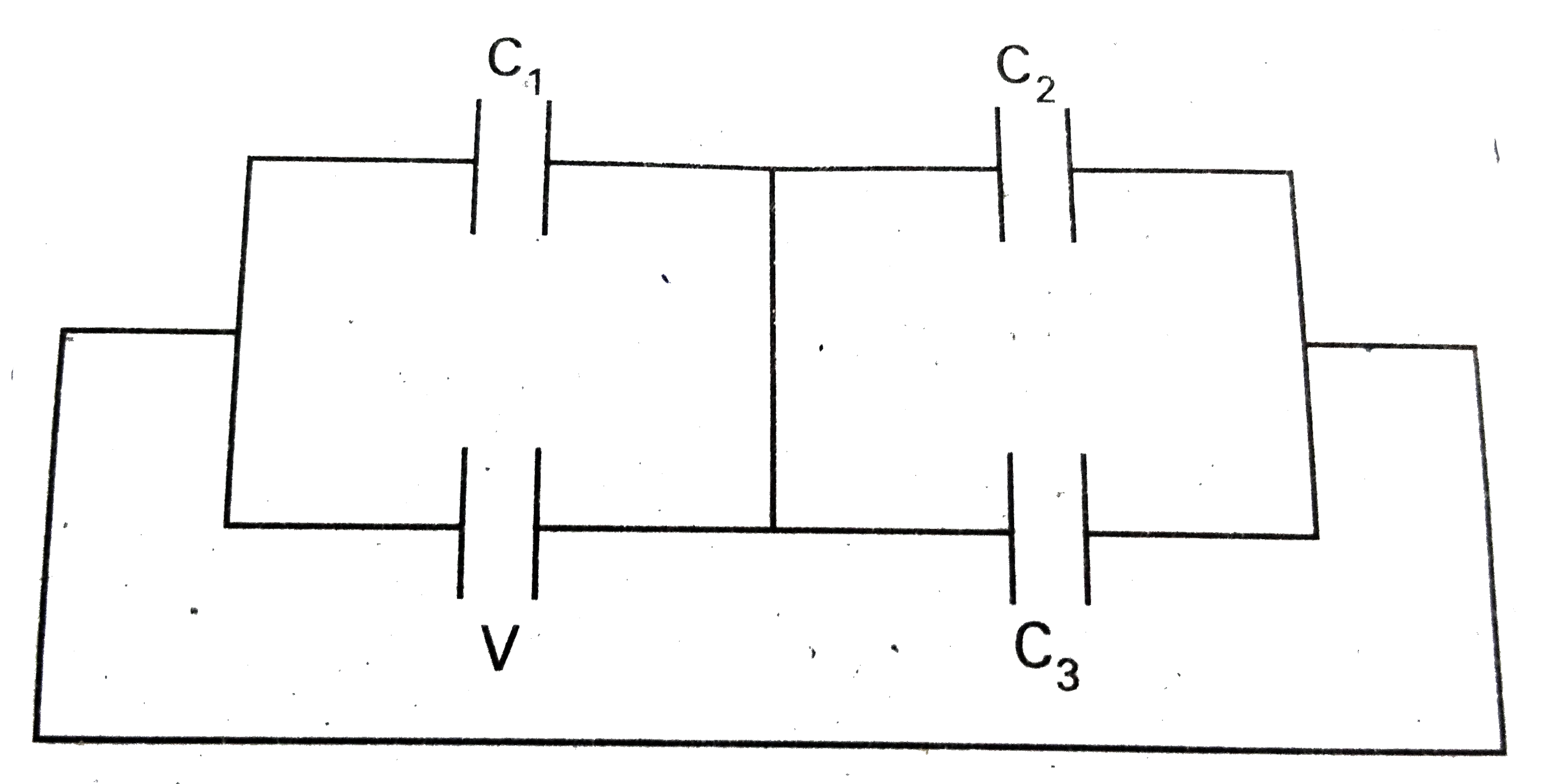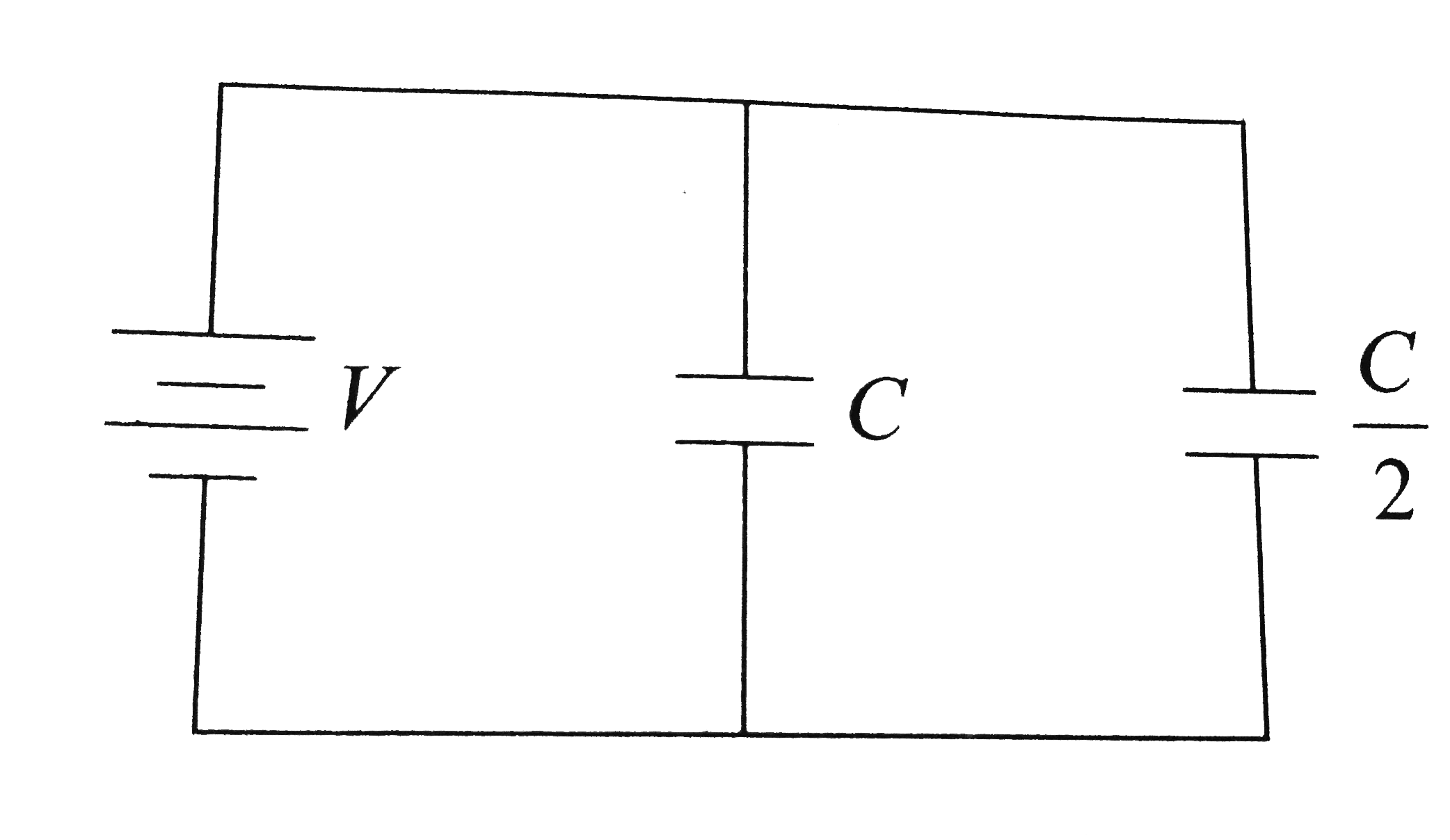In the circuit shown the battery of 'V' volts has no internal resistance . All three condensers are equal in capacity. Find the condenser that carries more charge ?
 .Solution in Telugu
.Solution in Telugu
The equivalent circuit to the given circuit is as shown

In series combination of capacitors, charge q flows through each capacitor.
Then q1=q=C1V1,q2=q=C2V2,
∴q1=q2=q3
Hence three capacitors , C1,C2 and C3 carry the same charge.
Topper's Solved these Questions
- ELECTROSTATIC POTENTIAL AND CAPACITANCEBook:VIKRAM PUBLICATION ( ANDHRA PUBLICATION)Chapter:ELECTROSTATIC POTENTIAL AND CAPACITANCEExercise:Very Short Answer Questions
Explore 10 Videos
- ELECTROSTATIC POTENTIAL AND CAPACITANCEBook:VIKRAM PUBLICATION ( ANDHRA PUBLICATION)Chapter:ELECTROSTATIC POTENTIAL AND CAPACITANCEExercise:Short Answer Questions
Explore 5 Videos
- ELECTROMAGNETIC WAVEBook:VIKRAM PUBLICATION ( ANDHRA PUBLICATION)Chapter:ELECTROMAGNETIC WAVEExercise:ADDITIONAL EXERCISES
Explore 19 Videos
- MAGNETISM AND MATTERBook:VIKRAM PUBLICATION ( ANDHRA PUBLICATION)Chapter:MAGNETISM AND MATTERExercise:Additional Exercises
Explore 19 Videos
Similar Questions
Can there be electric potential at a point with zero electric intensity ? Give an example.
View SolutionDerive an expression for the electric potential due to a point charge.
View SolutionSuppose that the electric field part of an electromagnetic wave in vacuum is E={(3.1 N/C) cos [(1.8 rad/m)y+{5.4×106 rad/s} t]} i.
What is the direction of propagation ?
View SolutionWhy does a paramagnetic sample display greater magnetisation (for the same magnetising field) when cooled?
View SolutionTwo condensers, one of capacity C and the other of capacity C/2 are connected to a V volt battery, as shown.

The work done in charging fully both the condensers is
View SolutionA 2μF condenser is charged upto 200 volt and then battery is removed. On combining this with another uncharged condenser in parallel, the potential difference is found to be 40 volt. Find the capacity of second condenser (in μF)
View SolutionTwo condenser, one of capacity C and the other of capacity (C )/(2) , are connected to a V volt battery, as shown in figure. The work done in charging fully both the condensers is
View SolutionTwo condensers, one of capacity C and the other of capacity C2 , are connected to a V-volt battery, , as shown

The work done in charging fully both the condensers is
View SolutionThe capacity of a condenser A is 10μF and it is charged to a battery of 100 volt. The battery is disconnected and the condenser A is connected to a condenser B the common potential is 40V. The capacity of B is
View SolutionA battery of emf V volts, resistances R_(1) and R_(2) , a condenser C and switches S1, and S2, are connected in a circuit as shown. The capacitor C gets fully charged to V volts when
View SolutionTwo condensers, one of capacity C and the other of capacity C/2 are connected to a V volt battery, as shown.

The work done in charging fully both the condensers is
View SolutionA condenser of 10μF capacity is charged at 100 volt. The energy stored by the condenser is :
View SolutionA 2 mu F condenser is charged upto 200 volt and then battery is removed. On combining this with another uncharged condenser in parallel, the potential difference is found to be 40 volt. Find the capacity of second condenser (in mu F )
View SolutionTwo condensers, one of capacity C and the other of capacity C/2 are connected to a V volt battery, as shown.

The work done in charging fully both the condensers is
View SolutionTwo condensers, one of capacity C and the other of capacity C/2 are connected to a V volt battery, as shown.

The work done in charging fully both the condensers is
View Solution
